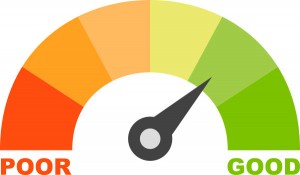What is a pScore?
Years ago, computers were slow, social networks didn’t exist, and search engines were vying for position as leader. Since then, the internet has evolved. But over this evolution, how we think about advertising online hasn’t changed much at all, and it’s costing us millions.
Modern Tracking
 Today, we know virtually everything about the people who visit our websites. We know how old they are, what food they like, whether or not they’re looking for a new pair of shoes… It’s creepy, isn’t it? But when it comes to attracting these people to our websites, products, or services, we still pay by the click. It’s simple, it’s straightforward, and we feel like we’re getting decent results. But there’s an inherent problem here.
Today, we know virtually everything about the people who visit our websites. We know how old they are, what food they like, whether or not they’re looking for a new pair of shoes… It’s creepy, isn’t it? But when it comes to attracting these people to our websites, products, or services, we still pay by the click. It’s simple, it’s straightforward, and we feel like we’re getting decent results. But there’s an inherent problem here.
Advertising publishers like Google, Facebook, and Twitter charge you by the click. And they don’t just charge you, they force you to bid for those clicks. And while this makes them more and more money, we don’t demand better, and it’s all for one simple reason:
We don’t know if better is even possible.
Behavior is Key
 What if one of these major companies sold advertising, but instead of just telling you how many clicks converted into sales, they also broke down your product by its attributes and compared those features to similar products sold by your competitors? And what if they didn’t stop there? What if you could actually drill into even the smallest aspects of a product and discover why your item wasn’t selling at its highest potential? What if you could change one little thing and triple sales, but all you’re missing is a single, critical datapoint?
What if one of these major companies sold advertising, but instead of just telling you how many clicks converted into sales, they also broke down your product by its attributes and compared those features to similar products sold by your competitors? And what if they didn’t stop there? What if you could actually drill into even the smallest aspects of a product and discover why your item wasn’t selling at its highest potential? What if you could change one little thing and triple sales, but all you’re missing is a single, critical datapoint?
You could visit with some marketing gurus and pay them crazy amounts of money to handle your pay-per-click campaigns or write your ad copy. But the good agencies are prohibitively expensive, and the bad ones don’t do much at all. At best, you’re going to pay hundreds of dollars to have someone look for and fix basic mistakes. Mistakes the major companies (like Google and Facebook) should have pointed out to you in the first place.
The key to doing better is understanding buyer behavior. If you know what people are buying, then you’ll know what to sell them. It’s really that simple.
Introducing pScores
 This is where bookSCREAM comes in. By leveraging deep data, we can see exactly how buyers behave, and we provide that information directly to authors and publishers who advertise with us. We call them pScore Reports, and they’re the bomb.
This is where bookSCREAM comes in. By leveraging deep data, we can see exactly how buyers behave, and we provide that information directly to authors and publishers who advertise with us. We call them pScore Reports, and they’re the bomb.
pScore Reports don’t report clicks, because clicks don’t matter. Sales matter. We can prove this fact by asking one simple question:
Would you rather have ten percent of your shoppers become paying customers, or would you rather have ninety percent of your shoppers become paying customers?
See what we did there? It doesn’t matter how you get the paying customers. What matters is that more of them start buying. Knowing how to improve an ebook ad, store page, cover, or description will improve conversion across the board, not just through a single ad. Split testing can finally be done with pinpoint accuracy. You can finally know if you’re paying for clicks from the wrong audience. You can finally know if your product needs a makeover.
The bottom line: Buying 1,000 clicks for $20 and only getting ten paying customers is not a good value. Buying 1,000 clicks for $20 and getting 400 paying customers is both a fabulous deal and a no-brainer.
The Data
 We source data from a proprietary tracking service, a sister service to bookSCREAM and part of the Neurocore Systems family. This system uses neural networks and deep tracking to determine which metrics we should focus on, and how we should present those metrics to users. As the system gathers enough data to make new metrics ready to present, we combine them with bookSCREAM’s internal data and analytics and release them for viewing via pScore Reports.
We source data from a proprietary tracking service, a sister service to bookSCREAM and part of the Neurocore Systems family. This system uses neural networks and deep tracking to determine which metrics we should focus on, and how we should present those metrics to users. As the system gathers enough data to make new metrics ready to present, we combine them with bookSCREAM’s internal data and analytics and release them for viewing via pScore Reports.
The Matter of Metrics
 pScore Reports are littered with metrics by design, but this can be confusing. Deciding which bits of a pScore are important for you can be tricky and take a little time and experimentation. It takes a little ingenuity to really put pScores to work. We’re happy to answer any questions, but we’re certain you’ll discover that the best way to engage with your pScore Report is to plan your promotion with your pScore Report in mind. Reading pScore results without any real goal in mind won’t help you much.
pScore Reports are littered with metrics by design, but this can be confusing. Deciding which bits of a pScore are important for you can be tricky and take a little time and experimentation. It takes a little ingenuity to really put pScores to work. We’re happy to answer any questions, but we’re certain you’ll discover that the best way to engage with your pScore Report is to plan your promotion with your pScore Report in mind. Reading pScore results without any real goal in mind won’t help you much.
Leveraging a Promotion
 In order to use pScores effectively, you’ll need to plan ahead. Consider setting up a promotion with your favorite advertiser. Once the promotion is over, check your pScore and see how your book fared versus other books we tracked on that day. If it performed poorly, perhaps your favorite advertiser isn’t working as well as you thought! You can do this over and over with different advertisers until you find the best pScore result.
In order to use pScores effectively, you’ll need to plan ahead. Consider setting up a promotion with your favorite advertiser. Once the promotion is over, check your pScore and see how your book fared versus other books we tracked on that day. If it performed poorly, perhaps your favorite advertiser isn’t working as well as you thought! You can do this over and over with different advertisers until you find the best pScore result.
Once you know where to advertise, it’s time to figure out how to advertise. Start changing a few things about your book. Try a new description. Try a new price point. You might even try alternate genres. Compare the performance of these attributes with other books, and you’ll be tweaking your promotions with real data!
So don’t delay. The sooner you start using pScore Reports, the sooner you’ll start seeing results. Click here to visit our Author page, and see how we can help!